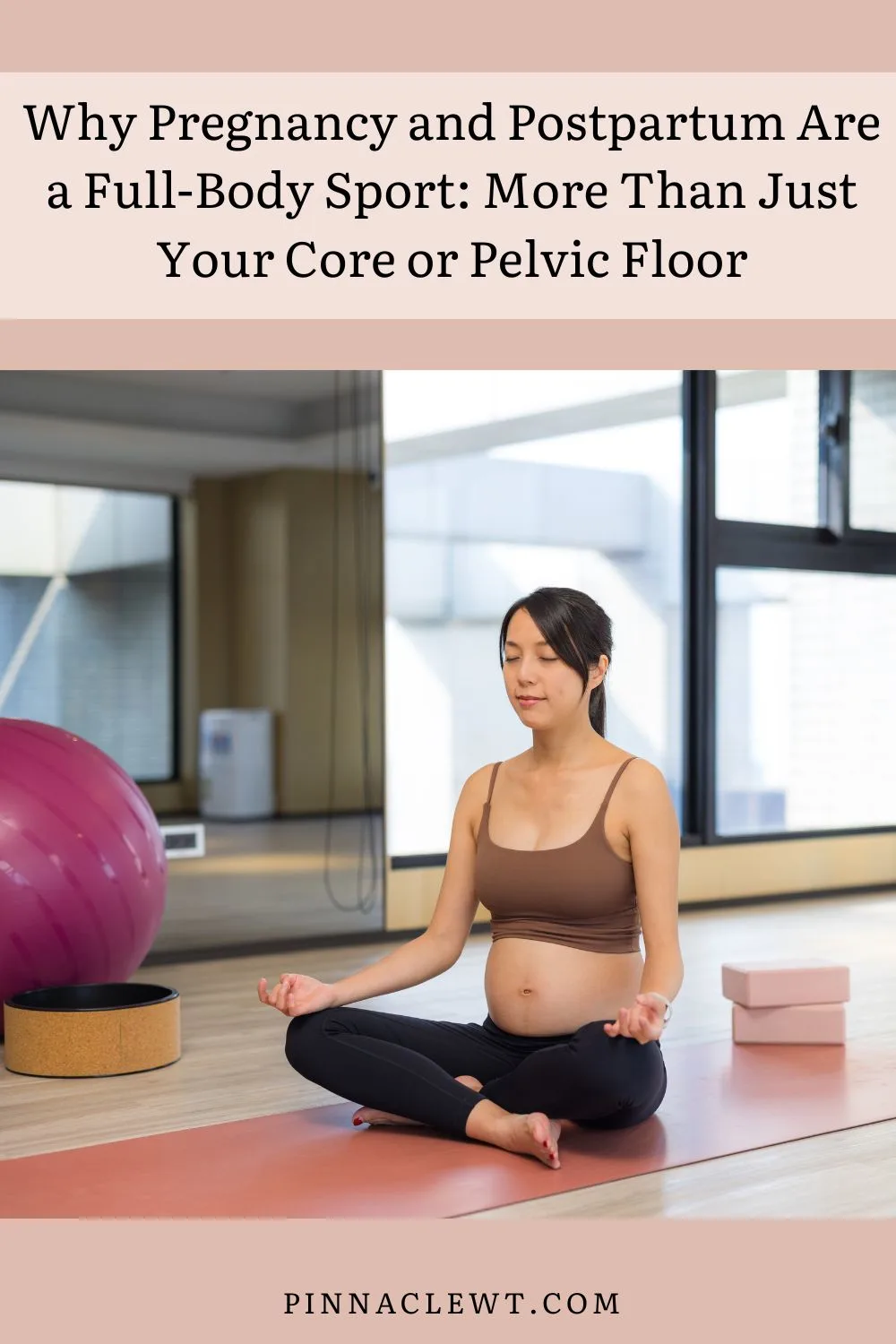Your Whole Body Changes During Pregnancy — And That’s Exactly What Pelvic PT Addresses
When most people think about pregnancy or postpartum recovery, they picture the belly or the pelvic floor. Maybe you’ve been told it’s all about crunches, kegels, or “getting your abs back.” But here’s the truth: pregnancy and postpartum are a full-body sport. Every single system in your body is impacted.
Your ligaments soften. Your ribcage shifts. Your breath changes. Your feet may widen, your hands might ache, and your back and neck often carry more than their share of the load. Add in the emotional weight, the hormonal changes, and the daily demands of caring for a newborn, and it’s no wonder so many women feel like their bodies no longer belong to them.
The problem is that postpartum care often zooms in on one small piece—your belly or your pelvic floor—and misses the rest of the story. That’s where pelvic physical therapy steps in. It’s not about one muscle group. It’s about the whole body, the whole person, and giving you the tools to heal, move, and thrive.
The Myth: It’s Just About the Pelvic Floor or Belly
Most women are told at some point that their pregnancy and postpartum journey comes down to “strengthening their core” or “doing kegels.” Social media reinforces this, and even the six-week medical clearance often centers only on whether you can resume activity—without much guidance on how to truly recover.
The problem with this narrative is that it overlooks the reality: pregnancy and postpartum affect far more than your abdominal wall or pelvic floor. When the focus is too narrow, women can feel dismissed or confused when they deal with back pain, wrist pain, constipation, or fatigue. They may wonder, Why didn’t anyone warn me about this?
The truth is that pregnancy and postpartum impact every region of the body. Not every woman will experience every change, but these shifts are common enough that pelvic PTs see and treat them every single day
The Truth: Pregnancy and Postpartum Are a Full-Body Sport
Pregnancy and postpartum don’t just touch one part of you. They change your structure, your movement, your breath, your energy, and even the way your body responds to stress. Below are some of the most common areas affected. Remember: this list is not meant to say you will experience all of these changes. But these are very common shifts in this life phase, and as pelvic PTs, we are trained and ready to address them all.
Spine & Pelvis
Your center of gravity shifts forward in pregnancy, and hormones create increased laxity in your ligaments. This combination often leads to back pain, sacroiliac joint discomfort, or pelvic girdle pain. These aches are not just “part of pregnancy”—they’re signals that your body is adapting and needs support.
Action tip: Practice gentle pelvic tilts and supported rest positions to relieve pressure.
Core & Abdominal Wall
As your belly grows, your abdominal wall stretches and the muscles of your deep core lose their ability to coordinate. Many women experience diastasis recti, where the midline stretches.
Postpartum, this can show up as weakness, bulging, or difficulty generating tension for everyday tasks.
Action tip: Instead of crunches, start with breath-led core engagement—focusing on exhale with gentle abdominal connection.
Breath & Ribcage
Your diaphragm shifts upward as the baby grows, limiting expansion into the back and sides of the ribcage. By the end of pregnancy, the lumbar fascia can become restricted as your back works overtime to hold you upright. Postpartum, breath training into the back and sides supports core recovery and helps restore mobility.
Action tip: Place your hands on the sides of your ribcage and practice slow inhales, expanding into your palms.
Upper Back & Neck
Feeding, carrying, and rocking a newborn create significant upper back and neck strain. Add hours spent sitting in less-than-ideal positions, and it’s no surprise many women deal with stiffness or even nerve irritation.
Action tip: A seated chest opener (hands behind head, elbows wide, gentle arching back over a chair) can release tension.
Hands & Wrists
“Mom thumb” (De Quervain’s tenosynovitis) and carpal tunnel syndrome are common in the postpartum phase. These come from repetitive lifting, holding, and feeding positions that strain small joints and tendons.
Action tip: When lifting your baby, tuck your thumb in next to your hand rather than holding it out wide from the other fingers. It’s that outstretched “open thumb” lifting pattern that irritates the tendon. Small adjustments like this reduce strain and allow tissues to heal.
Your pelvic PT can also teach kinesiotaping techniques that offload the tendon and give you relief while you heal.
Feet & Ankles
Hormonal changes loosen the ligaments of your feet, which may widen or flatten as a result. Postpartum, weak foot muscles can make it harder to activate your glutes or stabilize your balance.
Action tip: Try the “short foot” exercise—press your big toe into the floor while drawing the ball of the foot toward your heel, lifting your arch slightly.
Scars & Tissue
C-section scars, perineal tears, and episiotomy scars can leave behind fascial restrictions that affect mobility and comfort. Without guidance, many women don’t realize scar tissue can be treated, softened, and integrated back into healthy movement.
Action tip: Gentle scar massage, once cleared by your provider, helps restore mobility.
Nervous System & Energy
Pregnancy and postpartum are stressful seasons. Sleep deprivation, hormonal shifts, and the emotional load of caring for a baby can leave the nervous system stuck in “fight or flight.” This affects digestion, healing, and even pelvic floor function.
Action tip: Slow exhales (longer than your inhales) trigger the vagus nerve and help reset your system.
Foundational Health
Healing tissue requires energy and raw materials. That’s where hydration, electrolytes, and foundational minerals like magnesium come in. Magnesium supports sleep, bowel regularity, and muscle recovery. Protein-rich meals stabilize blood sugar and provide the building blocks for healing. Yet these are rarely emphasized in postpartum care.
Action tip: Aim for 25–30 grams of protein at meals and consider adding an electrolyte drink daily.
How Pelvic PT Addresses It All
Pelvic physical therapy is not just about Kegels. In a session, we look at how you breathe, how you move, how your tissues are recovering, and how your habits are supporting (or straining) your body.
In addition to core and pelvic floor assessment and treatment, a pelvic PT session might also include:
- Guided breathwork and ribcage mobility
- Core coordination training
- Hip and foot strengthening
- Scartissue care
- Strategies for mom thumb and upper back or neck tension or pain
- Prolapse symptom management
- Education on posture, alignment, and ergonomics with home and baby care
- Simple holistic guidance—hydration, protein, electrolytes, magnesium, and habit stacking
What makes this care unique is that it’s not about giving you a giant list of things to do. It’s about identifying the root causes of your symptoms and helping you integrate small, realistic strategies into daily life.
Action Steps You Can Start Today
Here are a few simple steps you can try at home:
- Breathing Reset → Place your hands on your ribcage and practice 5 slow inhales, expanding into the sides and back.
- Short Foot Exercise → Practice lifting your arches while brushing your
- Neck & Upper Back Release → Open your chest daily with a doorway
- Hydration Boost → Add electrolytes or a pinch of mineral-rich salt to your
- Scar Care → If you have a C-section scar and are cleared, gently massage with lotion to improve mobility.
Common Questions
Is it too late to start recovery if I’m years postpartum?
No. The body adapts at any stage. Whether it’s been months or decades, pelvic PT can help you reconnect, strengthen, and reduce symptoms.
Should I see a pelvic PT if I had a C-section?
Yes. Scar tissue, breath changes, and core coordination still need support. A C-section is major abdominal surgery, and recovery deserves attention.
Can pelvic PT help with things like mastitis?
Yes. Mastitis often requires medical evaluation, and pelvic PT can guide you in supportive strategies such as lymphatic drainage massage, exercises, posture adjustments, modalities that can be used in clinic and at home, and gentle mobility that encourages circulation and healing.
We look at the body as a whole, which means addressing how your breath, stress, and daily habits can either support or slow recovery.
Whole-Body Healing Is Possible
Pregnancy and postpartum are not conditions to “bounce back” from with a few kegels or quick fixes. They are profound, whole-body experiences that call for equally whole-body support. Your back, hips, feet, core, breath, hands, scars, and even your nervous system—all deserve attention.
In my work as a pelvic physical therapist, this means we don’t just talk about exercises. We look at how your body is moving, how your breath is supporting (or straining) your core, and how scar tissue or posture may be holding you back. We also go further—into hydration, nutrition, minerals like magnesium, and simple holistic habits that aren’t typically addressed in postpartum care but make a powerful difference in energy, recovery, and resilience.
You deserve to feel better in your body. With the right guidance, healing becomes less about piecing yourself back together and more about learning to support your body in this new season. That’s exactly what pelvic PT offers: care that addresses it all—so you can heal fully, not partially.
Ready to Take the Next Step?
If you’re ready to start feeling better in your body, I’d love to help.
At Pinnacle Women’s Therapeutics, we specialize in full-body pelvic health care for women in every season—pregnancy, postpartum, and beyond.
Book an appointment to begin your recovery journey today.




